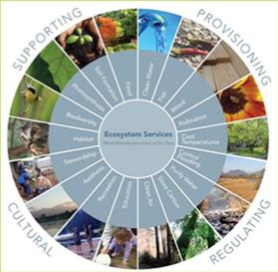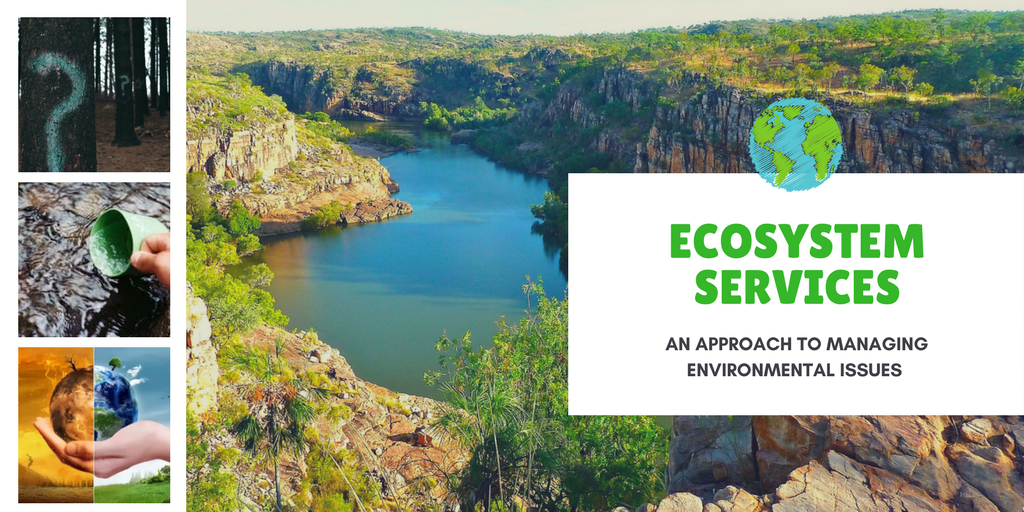Download PDF: ISPL Insight – Ecosystem Services Part 2
In recent years, there has been a growing understanding and interest in ecosystem services by Governments, communities and land managers. But, what exactly are ecosystems services? How do we measure or monitor them? And should we consider ecosystem services in our approach to managing environmental issues for development projects?
I started to answer some of these questions in my Insight Post from July 2017 (I recommend you check this out! – Ecosystems Services – Key Concepts). Knowing that ecosystem services are vital for human life by maintaining healthy ecosystems, is it possible to use ecosystem services as an approach to managing environmental issues?
Ecosystem Services and Environmental Impact Assessment
Environmental Impact Assessment (EIA) is a process of assessing the likely environmental impacts of a proposal and identifying ways that these impacts can be lessened or managed. When we think of EIA, we most often think of large projects and developments and the associated approvals which are assessed at a high level (such as through the Environmental Protection Authority). In reality, EIA is not limited to large projects or significant environmental impacts. Instead, EIA is a process used for all types of activities that could have an impact on the environment. EIA is often completed using a risk-based approach for a range of environmental factors. This approach often does not consider Ecosystem Services.
I propose that Ecosystem Services should play a role in the EIA process because they help to highlight the intricate way humans and ecosystem health are linked. This has the potential to provide a more in-depth assessment of the true impacts of a project on the environment through the alteration or loss of ecosystem services. Potentially raising impacts or issues which would not have been previously considered.

There is little guidance available for environmental practitioners on how to integrate ecosystem services into EIA. Several guidelines have been proposed including the Convention on Biological Diversity’s voluntary guidelines on including biodiversity and Ecosystem Services in impact assessment (Slootweg, et al. 2006) the OECD’s recommendations on how to incorporate Ecosystem Services in Strategic Environmental Assessments (OECD 2006) and the World Resources Institute document Weaving Ecosystem Services into Impact Assessment (WRI 2013). These follow a general process of:
- Identifying and prioritising the ecosystem services
- Establish or understand baseline information of the ecosystem service
- Assess the impacts on the ecosystem service
- Mitigate impacts, manage impacts and monitor the ecosystem service
(Damigos, et al. 2015)
Incorporating Ecosystem Services into Environmental Management
Post EIA, assuming subsequent approval, the focus turns to environmental management and ways to lessen or mitigate impacts to the environment from the development activities. The management of ecosystems and the environment can be a difficult and complicated matter – in any situation. For ecosystem services to be incorporated into environmental management, at any scale, an understanding of the relationships between the ecosystem service and the surrounding environment is required. This also includes how variability in the provision of this ecosystem service will influence the surrounding environment (Kremen 2005).
But, how do we achieve this when we don’t know much about the ecosystem services we need to manage?
 Firstly, we need to identify the ecosystem services which are provided in the development area and determine how vulnerable these are to the activity – this can be achieved through incorporating ecosystem services into EIA. Research suggests that management of the ecosystem services can be achieved through the valuation of ecosystem services (identifying their worth either in a dollar figure or to healthy ecosystems / human benefits) and the development of indicators to measure changes to the ecosystem services and subsequent benefits (or loss of) to ecosystems and humans. This information can be incorporated into planning and management decisions with the aim of maintaining the ecosystem services at a level which still supports healthy ecosystems and human benefits.
Firstly, we need to identify the ecosystem services which are provided in the development area and determine how vulnerable these are to the activity – this can be achieved through incorporating ecosystem services into EIA. Research suggests that management of the ecosystem services can be achieved through the valuation of ecosystem services (identifying their worth either in a dollar figure or to healthy ecosystems / human benefits) and the development of indicators to measure changes to the ecosystem services and subsequent benefits (or loss of) to ecosystems and humans. This information can be incorporated into planning and management decisions with the aim of maintaining the ecosystem services at a level which still supports healthy ecosystems and human benefits.
It should be noted that managing ecosystem services is challenging particularly when it comes to determining the value of the ecosystem service and the trade-offs that may be required due to landscape-level changes (Groot, et al. 2010).
Is it possible to restore ecosystem services?
 The next question that arises from development projects is rehabilitation. When it comes to ecosystem services is it possible to restore a degraded service or replace a lost service? To some extent rehabilitation activities focus on some environmental factors which are also ecosystem services such as water quality and biodiversity. Addressing ecosystem services for development projects requires first to examine the ecosystem services in the area (ideally a process completed during EIA and environmental management throughout the life of the project). Restoration activities alone may not be enough to enhance biodiversity and ecosystem services, but it will increase the ecosystem services present compared to degraded sites (Montoya, Rogers and Memmott 2012, Bullock, et al. 2011). Focusing restoration activities to include ecosystem services would involve the identification and valuation of the service provided with the development of an effective monitoring regime. Not impossible and not unlike the processes currently in place for restoring degraded land.
The next question that arises from development projects is rehabilitation. When it comes to ecosystem services is it possible to restore a degraded service or replace a lost service? To some extent rehabilitation activities focus on some environmental factors which are also ecosystem services such as water quality and biodiversity. Addressing ecosystem services for development projects requires first to examine the ecosystem services in the area (ideally a process completed during EIA and environmental management throughout the life of the project). Restoration activities alone may not be enough to enhance biodiversity and ecosystem services, but it will increase the ecosystem services present compared to degraded sites (Montoya, Rogers and Memmott 2012, Bullock, et al. 2011). Focusing restoration activities to include ecosystem services would involve the identification and valuation of the service provided with the development of an effective monitoring regime. Not impossible and not unlike the processes currently in place for restoring degraded land.
Concluding Remarks
 What I am proposing here is not that we need to drastically change the way we currently undertake EIA, environmental management or restoration activities, but rather, that ecosystem services provides an alternative way to approach this work. Ecosystem services are widely becoming used by governments for policy making and in conservation and land management activities. Examining ecosystem services can provide a picture and understanding of how the environment and human life is interconnected. If this approach is being more actively considered or used across the world and in other sectors I think there is merit in considering ecosystem services further for development projects in Australia.
What I am proposing here is not that we need to drastically change the way we currently undertake EIA, environmental management or restoration activities, but rather, that ecosystem services provides an alternative way to approach this work. Ecosystem services are widely becoming used by governments for policy making and in conservation and land management activities. Examining ecosystem services can provide a picture and understanding of how the environment and human life is interconnected. If this approach is being more actively considered or used across the world and in other sectors I think there is merit in considering ecosystem services further for development projects in Australia.
What is your opinion?
References and Other Useful Sources
Bullock, J, J Aronson, A Newton, R Pywell, and J Rey-Benayas. 2011. “Restoration of ecosystem services and biodiversity: conflicts and opportunities.” Trends in Ecology and Evolution 541-549. http://www3.uah.es/josemrey/Docencia/Materia1Master/Bullock_RestorationReview_TREE_2011_print.pdf.
Costanza, R, R de Groot, P Sutton, S van der Ploeg, and S Anderson. 2014. “Changes in the global value of ecosystem services.” Global Environmental Change 152-158. http://wedocs.unep.org/bitstream/handle/20.500.11822/19113/Costanza_et_al_GEC_2014_%2B_SI.pdf?sequence=1&isAllowed=y.
Damigos, D, M Menegaki, D Kaliampakos, and K Vassilios. 2015. “Rethinking impact assessment of mining projects in the context of ecosystem services.” Proceedings of the 24th International Mining Congress of Turkey. 53-64. https://www.researchgate.net/publication/282068771_Rethinking_impact_assessment_of_mining_projects_in_the_context_of_ecosystem_services.
Groot, R, R Alkemade, L Braat, L Hein, and L Willemen. 2010. “Challenges in integrating the concept of ecosystem services and values in landscape planning, management and decision making.” Ecological Complexity 260-272. https://www.sciencedirect.com/science/article/pii/S1476945X09000968.
Kremen, C. 2005. “Managing ecosystem services: what do we need to know about their ecology?” Ecology Letters 468-479. https://pdfs.semanticscholar.org/2fb0/be288c9e03a8703e2f4341a48fe3edb91fa7.pdf.
Montoya, D, L Rogers, and J Memmott. 2012. “Emerging perspectives in the restoration of biodiversity-based ecosystem services.” Trends in Ecology and Evolution 1-7. http://lerf.eco.br/img/publicacoes/2012_2211%20Emerging%20perspectives%20in%20the%20restoration%20of%20biodiversity%20based%20ecosystem%20services.pdf.
OECD. 2006. Applying Strategic Environmental Assessment: Good Practice Guidance for Development Cooperation. OECD.
Slootweg, R, A Kolhoff, R Verheem, and R Hoft. 2006. Biodiversity in EIA and SEA. Background document to CBD Decision VII/28: voluntary guidelines to biodiversity-inclusive impact assessment. Netherlands: Commission for Environmental Assessment.
WRI. 2013. “Weaving Ecosystem Services into Impact Assessment: A step by step method.”

